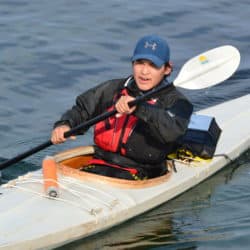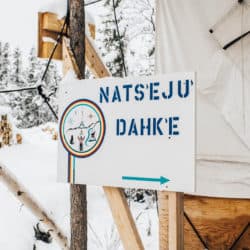This is the first in a series of profiles about past winners – “laureates” – of the Arctic Inspiration Prize. “By the North, for the North,” the prize celebrates and provides seed funding every year to groups working to develop new and creative projects that solve challenges in the North.
Northerners helping Northerners is a way of life in the Arctic. Living in remote communities far from major centres means residents need to rely on and help each other in many different ways. Ingenuity is an essential part of survival. And sometimes that ingenuity results in a prize-winning transformational technology.
Across the North, the sea-ice season has traditionally been a time of opportunity. As the water freezes, ice transportation routes open up and hunting opportunities expand. Indigenous knowledge of seasonal changes has been key to using ice-based routes safely. However, a changing climate has introduced new concerns. The later onset of winter, shorter periods of deep freeze, more rain, and changeable snow and wind can make sea ice less predictable.
In Labrador, 2010 was a year of unusual winter weather. There was persistent rain in February, normally unheard of. The sea ice turned to slush, severely curtailing travel across normally frozen bays and inlets. As a result, many people didn’t have their normal access to country food or firewood – threatening food and energy security. There were reports of people going through the ice along traditional routes, which increased fear of travelling.
Trevor Bell, a professor of geography at Memorial University in St. John’s, Newfoundland, studies landscapes from a variety of perspectives, including geomorphic evolution, climate change impacts, and human-environment interactions. Research on glaciers and high Arctic landscapes led to his studying the impact of climate change on northern communities and collaborating to develop and adapt technologies for testing ice temperature and thickness. The project became known as SmartICE, for “sea-ice monitoring and real-time information for coastal environments.”
Bell’s team began by developing two sensors. One is stationary and operates autonomously: dubbed “SmartBUOY,” it’s anchored in a hole drilled into a solid stretch of ice where it will eventually freeze in place, measuring ice thickness and snow depth and transmitting the information by satellite. The second device, “SmartQAMUTIK,” is pulled behind a snowmobile to provide real-time measurements. Local Inuit knowledge informs the operation of both types of sensors, as the community is consulted at the beginning of each season to determine where to deploy them. In fact, SmartICE technology was never intended to replace Inuit knowledge of safe ice travel, which has been passed down through generations and continues to be shared through lived experience.
When prototypes of the devices were rolled out for testing in the pilot communities of Nain (Nunatsiavut) and Pond Inlet (Nunavut) in 2015, other northern communities took notice. With unprecedented ice conditions leading to increased search-and-rescue efforts that winter, requests to access a SmartICE monitoring system flowed in.
The growing demand made it necessary for Bell and his team to consider how to evolve the program. The original model of a community–university–government–industry research partnership was not going to meet the needs of every community that wanted and needed an ice-monitoring system. Their current funding had restrictions on its use: it was limited to technology development and demonstration and could not be used to finance expansion.
A new business model was up for discussion. The team wanted to honour its commitment to community, the environment, and youth training grounded in Inuit ways of knowing. After consulting with partners – including universities, industry, and community, government, and non-government organizations – a non-profit social enterprise model was adopted. Performance would be measured by looking not only at sales and profits, but at the positive impacts – social, environmental, economic – on communities. While the social enterprise concept is common in southern Canada, it is not well known in the North – at least, not yet.
Bell and his team put together an application for the Arctic Inspiration Prize, an annual award granted by the AIP Charitable Trust. Led by a majority of trustees from the North, it distributes seed money every year to groups working to develop new and creative projects that solve challenges in the North. There are no limits to the type of initiative that can apply: prizes have been awarded in the spheres of technology, environment, education, socio-economic development, heritage, arts and culture, and skills development. Two factors are key to a successful application: having a diverse team that includes Northerners and an initiative that addresses the root of an issue, not the symptoms.
The SmartICE application, entitled “From Community Partnership to Social Enterprise,” was successful and the team was awarded $400,000 – and the opportunity to launch a new development phase. The prize was an injection of essential core funding, says SmartICE executive director Carolann Harding: “Winning the AIP set the dream in motion. It not only provided SmartICE with the funding needed to get off the ground but afforded us the opportunity to really make an impact within the community by engaging and working with youth.”
The AIP is different from other funding sources, Bell notes. Importantly, the selection committees consist primarily of Northerners. “They can understand what you are trying to do and appreciate the challenges you are trying to overcome,” he says.
While Bell had a vision for the social enterprise and business aspirations for the project, they were not his areas of expertise. He relied on the relationships he had built through the development of SmartICE to that point to put together a compelling nomination with the help of partners and mentors, who wrote letters of support.
A central component of the AIP application was a knowledge-to-action plan – demonstrating how the work would progress from hypothesis, research, and data collection to actually making a difference. The critical piece was the proposal to establish a SmartICE production centre in Nain. The Northern Production Centre was launched in 2019, the first of its kind in Inuit Nunangat. There, Inuit youth are trained to assemble components of the SmartICE stationary sensors, which are then shipped to communities across the North. Training is provided in both technical competencies and social-emotional learning. It is a holistic approach, incorporating Inuit societal values such as caring for the environment and community and being innovative and resourceful. Young people learn skills that are transferable to other workplaces; many pursue further education.
Technology start-ups are emerging as an important sector in Canada’s economy, but they require funding and capital. “You need money to get money,” says Harding. Bell notes that “winning the AIP prize gave the organization a lot of credibility. It has been a passport to other opportunities.” SmartICE has been able to leverage the prize money to access other funding and investment.
The team is particularly proud of the social enterprise component of SmartICE: it makes it stand out when seeking funding opportunities. Not only do youth have the chance to learn traditional and modern skills; SmartICE also seeks to hire and train Inuit operators of the technology. Using local knowledge and observations in the data-collection process fosters community confidence in the information, which directly supports traditional hunting and fishing activities. “Community members become effective environmental monitors for their own communities,” says Bell.
There are opportunities for entrepreneurs to work with SmartICE. Inuit can develop businesses that make use of the ice data in their own communities while SmartICE continues to refine the technology. And awareness of the project’s success is expanding: there’s a waiting list of communities who want to participate and benefit from the economic and social opportunities it provides. During the 2020 ice season, trained Inuit were operating SmartICE equipment and services in 17 communities, from Nunatsiavut to Inuvialuit, with seven more in the planning stages.
There is a growing and urgent need for projects like this. In the face of climate change and the need for adaptation, “we can’t afford for SmartICE to fail,” Bell says. The social-enterprise and economic-development approach is putting tools directly in the hands of Inuit to help them take over the project. Bell’s goal is for it to be 100% Inuit-operated and -managed eventually.
Being a recipient of the AIP has brought many benefits to SmartICE. It strengthened the reputation of the organization and enabled them to network at a different level, including with other laureates. “We are proud to say we are a laureate of the Arctic Inspiration Prize,” Harding says. “There is something about being a laureate – a sense of community. It’s all about building capacity in the north and northern communities.”
It reflects a culture of saying “get to yes,” says Harding and is “an invitation to dream.” And it turns those dreams into reality, Bell adds. “SmartICE is proof.”
***
Photo courtesy of SmartICE’s Zack Coombs: Community members and SmartICE operators in Igloolik, Nunavut, deploy a SmartBUOY in March 2020. Data from the sensor is transmitted daily via satellite and made available to the community on SIKU.org.


